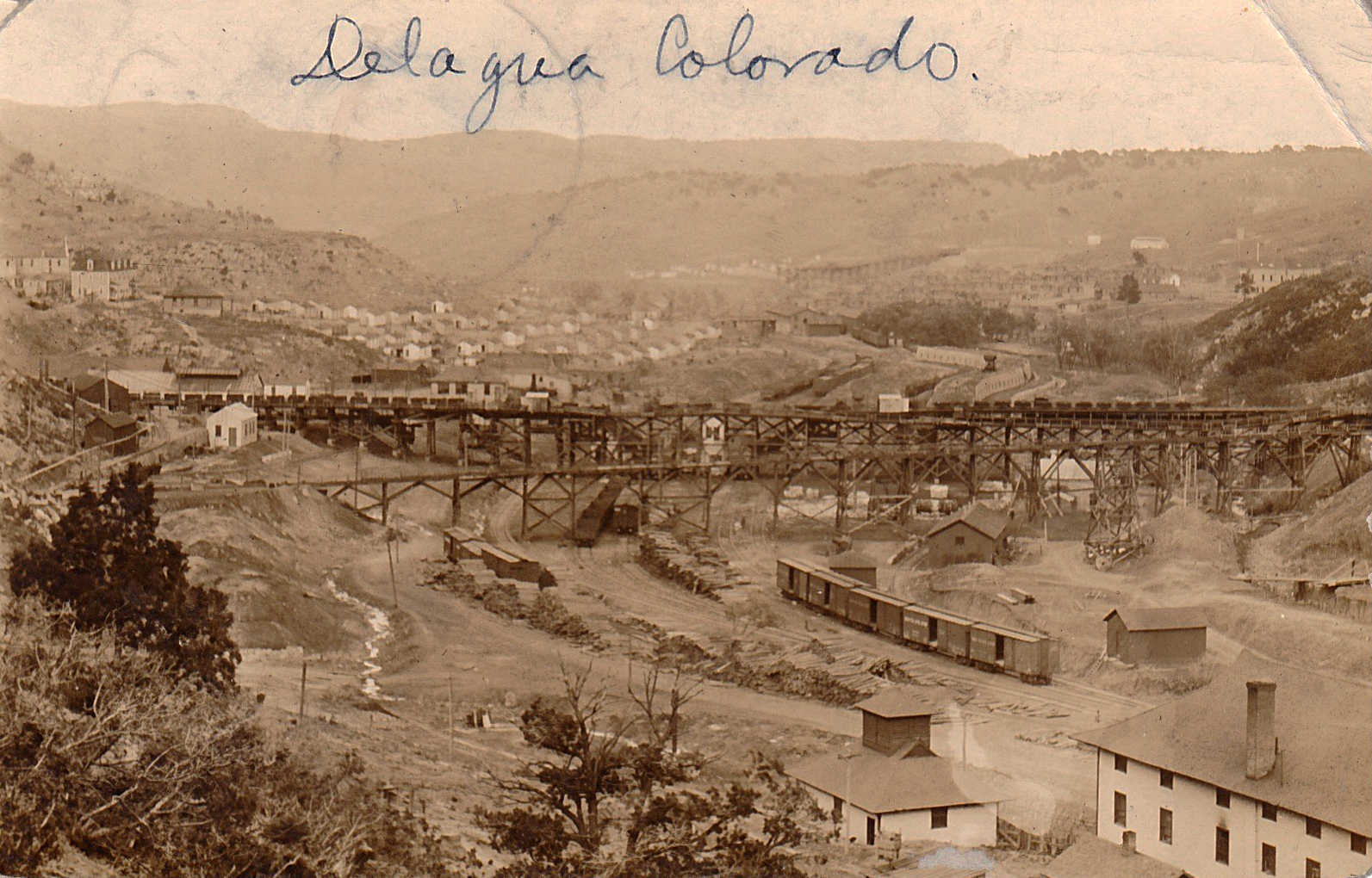Delagua was a coal mining company town located in Canon Del Agua (“Water Canyon”). It sat west of what is now Interstate 25, about 17 miles northwest of Trinidad in Las Animas county. The town was built (and owned) by the Victor Fuel Company after the company opened the coal mine in 1903. Miners were drawn to its attractive location at the head of the canyon and a good natural water supply. The extension of railroad tracks to the new town by the Colorado and Southeastern Railroad certainly boosted its fortunes. In 1922, the Delagua mine was the largest in Colorado, with a peak employment of over 900 men.
The Victor Fuel Company was formed by John C. Osgood, who is credited with organizing the Colorado Fuel and Iron Company (CF&I) in 1883. He decided to form the Victor Fuel Company after losing control of the CF&I board of directors to two new shareholders, John D. Rockefeller and Jay Gould. Osgood started the Victor Fuel Company to compete with CF&I, and Delagua was one of its first properties. Soon after, the company owned nine mines in Colorado, as well as some in New Mexico, thereby becoming the second largest coal producer in the state.
Delagua appears to have been a thriving community. In a 1917 publication of “Coal Age, “ author Frank Huskinson, who was the Chief Electrician in Delagua for the Victor-American Fuel Company, wrote an article describing Delagua as “one of the largest and finest ‘mining camps’ in the state.” He describes the Delagua Social Club, which had been formed about a year earlier:
The Social Club had two buildings formerly housing a saloon and dance hall, which were converted into a social center containing rooms for pool and billiards, a soda fountain and parlor, two bowling alleys with seats for spectators, and an area for table games, with no gambling allowed. The playing tables would be cleared for occasions such as banquets or dances. Music was provided by “a fine grafonola and an extensive collection of records.” (Grafonola was a genericized trademark for a phonograph which hid the amplifying horn inside a cabinet, making it look like a piece of furniture.) Larger dances were held in the second floor hall of the nearby Longfellow public school.
At the time the article was written, the Delagua Social Club had ordered “a fine new cash register that will serve almost all the purposes of a bookkeeper,” and the purchase of a player-piano was also being considered. The club boasted approximately 300 members. Membership required a $2.00 initiation fee and 50 cents a month in dues. Plans were in the works to install “bocho alleys for the benefit of the Slavish and Italian members, a swimming pool, and in fact all of the good clean amusements that the city can offer.”
The dangers inherent in mining made it inevitable that Delagua and other mining sites would be visited by disaster. The greatest was the Delagua mine explosion on Nov. 8, 1910, which killed 78 men. In February of that year, 75 miners were killed in an explosion at the Primero mine (located about 15 miles west of Trinidad), and in the month prior to the Delagua explosion, as many as 56 were killed at the Starkville Mine, located 7 miles outside of Trinidad.
Due to a decline in demand, the Delagua mine closed in March of 1952, with 120 men still on the payroll. Eighty-seven buildings and houses, mining equipment and machinery were put up for auction. The mine was subsequently leased to independent parties, but was finally abandoned in 1969. There is no town left.
REFERENCES:
- “Death at Delagua”, from “Huerfano World Journal – Huerfano – Las Animas – Colfax,” dated November 15, 2015, at https://huerfanoworldjournal.com/death-at-delagua/
- Fairway Flume, May 4, 1917, at https://www.coloradohistoricnewspapers.org
- “How a Western Coal-Mining Village Manages a Social Club,” by Frank Huskinson, Coal Age, July 1 – December 31, 1917, at https://books.google.com/books?id=G9s-AQAAMAAJ&pg=PA670&dq=delagua+colorado&hl=en&sa=X&ved=0ahUKEwia4_yLq9TbAhWPxVkKHRgWBusQ6AEILjAB#v=onepage&q=delagua%20colorado&f=false
- “Huerfano County, Colorado, Primero Mine” at http://www.kmitch.com/Huerfano/primero.html
- Spanish to English, Google Translate at https://translate.google.com/?sl=es&tl=en&text=canon%20del%20agua&op=translate
- “Starkville Mine Explosion,” United States Mine Rescue Association at https://usminedisasters.miningquiz.com/saxsewell/starkville_news_only.htm
- “Tally — A Coal Miner’s Daughter – Delagua the Early Years” blog by Nelda White, dated June 20, 2013, at https://www.travelblog.org/North-America/United-States/Colorado/Las-Animas/blog-792396.html
- Wikipedia at https://en.wikipedia.org/wiki/Delagua,_Colorado
- Wikipedia at https://en.wikipedia.org/wiki/Columbia_Grafonola

